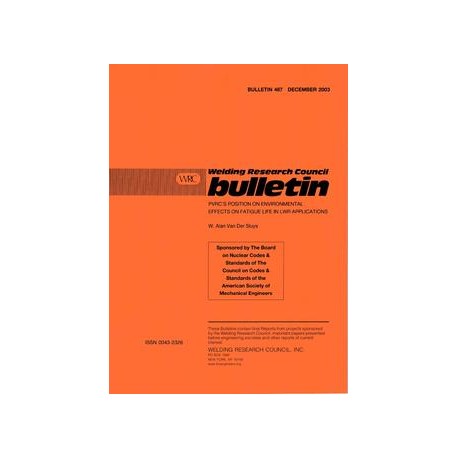Cart
0
Product
Products
(empty)
No products
To be determined
Shipping
$0.00
Total
Product successfully added to your shopping cart
Quantity
Total
There are 0 items in your cart.
There is 1 item in your cart.
Total products
Total shipping
To be determined
Total
New
Reduced price!
 View larger
View larger
 View larger
View larger
WRC 487
M00009575
New product
WRC 487 PVRC'S Position on Environmental Effects on Fatigue Life in LWR Applications
Bulletin / Circular by Welding Research Council, 2003
W. Alan Van Der Sluys
In stock
More info
Full Description
This Bulletin report describes the activities of the PVRC Steering Committee on Cyclic Life and Environmental Effects (CLEE) and the PVRC Working Group S-N Data Analysis. This report presents the PVRC recommendations to the ASME Board on Nuclear Codes and Standards (BNCS) concerning needed modifications to the ASME fatigue analysis procedure. The proposed modifications will account for the effect of the environment on the fatigue properties of the pressure boundary materials. These recommendations are in response to the following request from the BNCS:"BNCS Looks to PVRC to Obtain, Characterize, and Report in Sufficient Detail to ASME Such Data as May be Useful to ASME in its Evaluation of the Fatigue Curves of Sections IV and XI"
The PVRC Committee has worked closely with, and received comments from, investigators in Japan, Europe, and America and has reviewed essentially all public domain data. We are particularly appreciative of databases and analyses provided by those in Japan working on MITI projects and in America at the Argonne National Laboratory.
We believe we have been successful in guiding the experimental work and forging a consensus with regard to the key issues that were formerly much less than clear. Considering all well characterized, available data, PVRC has drawn the following major conclusions:
(1) ASME Section III should adopt a procedure such as proposed in Section 7 of this report to apply an environmental correction factor, Fen, to life fractions calculated using the existing ASME S-N design curves when anticipated operating conditions are sufficiently severe that it is necessary to account for environmental effects.
(2) ASME Section XI should adopt a procedure such as proposed in a draft code case in Section 7 of this report and apply the environmental correction factor, Fen, to life fractions calculated using the existing ASME S-N design curves when it is necessary to account for environmental effects.
(3) The Fen models are shown to work well in predicting the effect of the coolant environments on the low cycle fatigue properties of stainless steel. The low cycle fatigue information on stainless steel in air, collected by the PVRC to perform the evaluation, does not appear to support the ASME mean data line for stainless steel, and more data are needed to adequately understand behavior.

